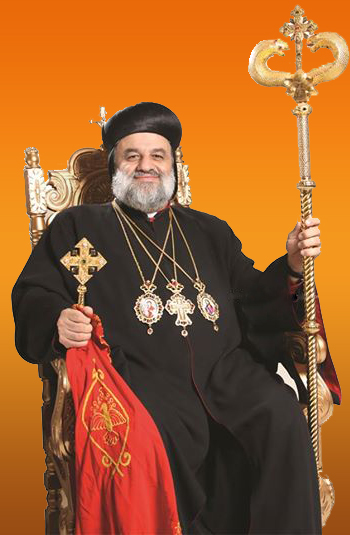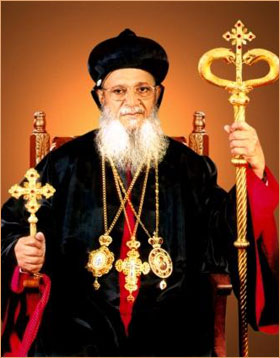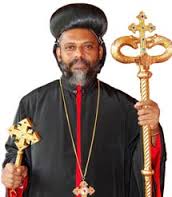


His Holiness Moran Mor Ignatius Aphrem II
Patriarch of Antioch and All the East
Supreme Head of the Universal Syriac Orthodox Church
Patriarch of Antioch and All the East
Supreme Head of the Universal Syriac Orthodox Church
His Beatitude Mor Baselios Thomas I
Catholicose of the East
Catholicose of the East

H.G. Mor Meletheose Yuhanon Metropolita
Thumpamon Diocese
Thumpamon Diocese
HISTORY OF THE SYRIAC ORTHODOX CHURCH
The Syrian Orthodox Church [earlier called The Church of Antioch] was established by St.Peter, the chief of the Apostles and the first patriarch in AD 37 at Antioch [now Antakya in Turkey] [see Acts.11:26,14:26]. The church suffered all kinds of tortures and hardships from all quarters right from its establishment, but its flag still soars high. Today the church is spread around the globe spanning 22 countries headed by a patriarch residing at Damascus in Syria.
A few Christian denominations can claim the antiquity of the Syrian Orthodox Church of Antioch (Syr. `idto suryoyto treeysath shubho), whose foundation can be traced back to the very dawn of Christianity. It justifiably prides itself as being one of the earliest established apostolic churches, if not the oldest. It was in Antioch, after all, that the followers of Jesus were called Christians as we are told in the New Testament. "The disciples were first called Christians in Antioch." (Acts 11:26)
The Church of Antioch is the second established church in Christendom after Jerusalem. The prominence of its Apostolic see is very well documented. In his Chronicon (I, 2), the church historian Eusebius of Caesarea tells us that St. Peter the Apostle established a bishopric in Antioch and became its first bishop. St. Peter was succeeded by Evodius. In another historical work, Historia Ecclesiastica, Eusebius tells us that Ignatius the Illuminator, "a name of note to most men, [was] the second after Peter to the bishopric of Antioch" (III, 36).
In the mid of the 5th century, the Bishop of Antioch, and his counterparts in Alexandria, Byzantium and Rome, would be called Patriarchs. Since 1293, the patriarchs of Antioch adopted the name Ignatius, after the Illuminator. The See of Antioch continues to flourish with His Holiness Patriarch Ignatius Zakka I, being the 122nd in the line of legitimate patriarchs.
The patriarchate was forced to move from Antioch in ca. A.D. 518, after a period of turbulent history, to various locations in the Near East until it settled in Deir az-Za'faran monastery in Mardin, Turkey, during the 13th century. After another period of heinous violence during and after World War I, which took the lives of a quarter million faithful, the patriarchate was transferred to Homs, Syria, in 1933, and later to Damascus in 1957.
The Syrian Orthodox Church is quite unique for many reasons. Firstly, it presents a form of Christianity which is Semitic in nature with a culture not far from the one Christ himself experienced. Secondly, it employs in its liturgy the Syriac language, an Aramaic dialect akin to the Aramaic spoken by Christ and the Apostles. Thirdly, its liturgy is one of the most ancient since it has been handed from one generation to another. Fourthly, and most importantly, it demonstrates the unity of the body of Christ by the multiethnic nature of its faithful: A visit to your local Syrian Orthodox Church in Europe or the Americas would demonstrate, for example, the blend of Near Eastern and Indian cultures in the motifs and vestments of clergy. The Syrian Orthodox faithful come primarily from Middle Eastern countries and the Indian state of Kerala, with many communities in the diaspora.
The Syrian Orthodox Church has been a member of the World Council of Churches since 1960, and is one of the founding members of the Middle East Council of Churches. The Church takes part in ecumenical and theological dialogues with other churches. As a result of these dialogues, the Church has issued two joint declarations with the Roman Catholic Church and another with the Eastern Orthodox churches.
The Church has been referred to by the name "Syrian Orthodox Church" in English. The Holy Synod of the Church adopted the name "Syriac Orthodox Church" in its session of Mar 28-Apr 3, 2000 due to the common identification of the term "Syrian" with the Republic of Syria in the English speaking world.
History
Throughout Syria and Mesopotamia, Aramaic, in its many dialectical forms, was the language of the land, and Syriac, originally the Aramaic dialect of Edessa in Northern Mesopotamia, seems to have been the most influential literary form of Aramaic. When we speak of Syriac Christianity, we refer to Christians whose native tongue was Syriac and/or who employed Syriac as their liturgical language.
Syrian Christianity was not centered just in Antioch, the Roman capital of Syria. In fact, Syrian Christianity can be traced further East in Mesopotamia. As local tradition tells us, Christianity was received in Edessa during the time of the Apostles. This is reported in a number of documents including Eusebius's Ecclesiastical History. He gives us the text of a correspondence between the city's king, Abgar Ukomo, and none other than Jesus Himself:
Abgar Ukomo, the toparch, to Jesus the good Savior who has appeared in the district of Jerusalem, greetings. I have heard concerning you and your cures, how they are accomplished by you without drugs and herbs ... And when I heard of all these things concerning you I decided that it is one of two things, either that you are God and came down from Heaven to do these things, or are the Son of God for doing these things. For this reason I write to beg you to hasten to me and to heal the suffering which I have ...
The reply, according to the same tradition, was carried by a certain Ananias:
Blessed are you who believed in me, not having seen me ... Now concerning what you wrote to me, to come to you, I must first complete here all for which I was sent, and after thus completing it be taken up to Him who sent me; and when I have been taken up, I will send to you one of my disciples to heal your suffering and give life to you and those with you.
The story continues to describe how one of the Seventy disciples was sent to King Abgar.
Historical literary sources tell us that by the second half of the second century there was an established church in the city, though probably most of the inhabitants remained pagan. The Chronicle of Edessa tells us that in the year 201, a disastrous flood destroyed the church of the Christians in the city. However, it took only about a century until most of the city was under the umbrella of Christianity. Edessa, indeed, prides itself as the first Kingdom that officially accepted the new faith.
India had its own share of Syrian Christianity. According to tradition, Christianity in India was established by St. Thomas who arrived in Malankara (Kerala) from Edessa in A.D. 52. The close ties between the Church in Malankara and the Near East go back to at least the fourth century when a certain Joseph of Edessa travelled to India and met Christians there. The church in Malankara is an integral part of the Syrian Orthodox Church with the Patriarch of Antioch as its supreme head. The local head of the church in Malankara is the Catholicose of the East, ordained by and accountable to the Patriarch of Antioch.
Syrian Christianity spread rapidly in the East. The Bible was translated into Syriac to serve as the main source of teaching as early as the second century. Till this day, the antiquity of the Syriac biblical versions is upheld with high esteem by modern scholars. In the words of Dr. Arthur V?s, "In our search for the oldest translation of the Greek original [of the New Testament] we must go back to the Syriac idiom" (Studies in the History of the Gospel Text in Syriac, p. 1). The same applies to the Hebrew Old Testament. In fact the Syrian Church Fathers made no less than six translations and revisions of the New Testament and at least two of the Old Testament. Their scholarship in this domain has no equal in Church history.
The Church of Antioch was thriving under the Byzantine Empire until the fifth century when Christological controversies split the Church. After the Council of Chalcedon in A.D. 451, two camps of the one Church emerged: The Greek Church of Byzantium and the Latin Church of Rome accepted Chalcedon, but the Syrian and Coptic (later Armenian as well) Churches rejected the council. The former group professed that Christ is in two natures, human and divine, whilst the latter adopted the doctrine that Christ has one incarnate nature from two natures. It is worth noting that the drafts of the Council were according to the position of the Syriac and Coptic Churches. The final resolution, however, was according to the doctrine of the Western Churches. The difference lies in the one preposition (in or from two natures). This schism had sad consequences on the Syriac Church during the next few centuries.
As the Emperor supported the Chalcedonian camp, the Syrian Church came under much persecution. Many bishops were sent to exile, most notably Patriarch Mor Severius, who was later given the epithet togho dsuryoye or 'Crown of the Syrians'. Mor Severius died in exile in 538. By the year 544, the status of the Syrian Church came to a low end when only three bishops remained. It was at this time that Mor Jacob Baradaeus appeared. Mor Jacob traveled to Constantinople for an audience with Empress Theodora, the daughter of a Syrian Orthodox priest from Mabbug, Syria, and wife of Emperor Justinian. Theodora used her influence to get Jacob ordained as bishop in 544. Later, Jacob would travel across the entire land reviving the Church. He managed to consecrate 27 bishops and hundreds of priests and deacons. For this, the Syrian Orthodox Church honors this saint on July 30 of every year, the commemoration of his death which took place in 578. A few centuries later, adversaries labeled the Syrian Orthodox Church 'Jacobite' after St. Jacob. The Syrian Orthodox Church rejects this belittling label which suggests that the Church was founded by St. Jacob.
Aside from their ecclesiastical role, Syrian Churchmen have contributed to world civilization. As early as the fourth century, academies and schools were set up in monasteries throughout Syria and Mesopotamia. Monks and scholars where busy studying the sciences of the Greeks, commenting and adding to them. It is no surprise that when the Arabs, who conquered the Near East at the end of the seventh century, wanted to acquire Greek knowledge, they turned to Syriac scholars and churchmen. Arab caliphs commissioned the Syrians to translate the sciences of the Greeks into Arabic. In his film Forgotten Christians, Christopher Wenner describes the impact of Syriac scholars and Churchmen when he describes the school at Deir al-Za'faran monastery, "It was through the monks here that the Arabs received Greek learning, and it was the Arabs of course who passed it back to Europe. Had it not been for the Syriac monks, we in Europe might never have had a renaissance."
The Syrian Orthodox Church survived under the dominion of many empires in the centuries that followed. Under the Arabs, Mongols, Crusades, Mamluks and Ottomans, the Syrian Orthodox Church continued its survival. Neither intimidation nor oppression could suppress the faithful.
Today, the Syrian Orthodox Church has faithful not only in the Middle East and India, but in Europe, the Americas and Australia as well. The distribution of the faithful can be seen from the organization of the Church today.
Church Hierarchy
The supreme head of the Syrian Orthodox Church is the Patriarch of Antioch and all the East. He also presides over the Holy Synod, the assembly of all bishops.
The local head of the church in Malankara (India) is the Catholicos of the East . He is under the jurisdiction of the Patriarch of Antioch and is accountable to the Holy Synod and the local Malankara Synod. He is ordained by the Patriarch. He presides over the local Holy Synod.
The local head of every archdiocese is an archbishop. He is under the jurisdiction of the Patriarch and is accountable to the Holy Synod. The archbishop is ordained by the Patriarch and at least two bishops.
Each parish is assigned a vicar. He is under the direct jurisdiction of his archbishop and is directly accountable to him. The parish is run by a board of trustees (or a committee) which is elected by the parishioners and approved by the archbishop.
Deacons assist the priest in the administration of the liturgy. Each archdiocese may have one archdeacon who is called "the right hand of the bishop." Only qualified and learned deacons are elevated to this office.
There are three ranks of priesthood in the Syrian Orthodox Church:
Episcopate: Within it there are the ranks of Patriarch, Catholicos, archbishop, and bishop.
Vicarate: Within it there are the ranks of chor-episcopos and pastor.
Deaconate: Within it there are the ranks of archdeacon, evangelical-deacon, subdeacon, lector or qoruyo and singer or mzamrono.
Data Source :Syriac Orthodox Resources Homepage.


Copyright © 2013 Mor Ignatius Jacobite Syrian Church, Ayroor All rights Reserved
Official website of Mor Ignatius Jacobite Syrian Church, Ayroor